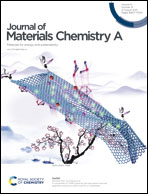A novel self-catalytic cooperative multiple dynamic moiety: towards rigid and tough but more healable polymer networks†
Abstract
A formidable scientific challenge for the development of self-healing polymers is how to rationally design molecular architectures that could integrate both highly efficient healing functions and excellent mechanical performances. Here, we present a novel rigid and tough but more healable polymer network enabled by self-catalytic cooperative multiple dynamic moieties (CMDMs) containing metal–ligand coordinations, multiple hydrogen bonds and reversible urea bonds. The strength and toughness of the materials are improved significantly via strong supramolecular interactions of CMDMs, resulting in a modulus, tensile strength and toughness up to 797.4 MPa, 73.6 MPa and 218.2 MJ m−3, respectively. The metal–ligand coordinations of CMDMs facilitate the dynamic exchange reactions between the urea bonds of CMDMs through a self-catalytic mechanism, providing the material with a much higher healing efficiency of 90% compared with 48% for the control sample without metal–ligand coordinations. CMDMs provide a novel paradigm for designing robust healable materials by integrating dynamic covalent bonds and supramolecular interactions into one single moiety.



 Please wait while we load your content...
Please wait while we load your content...